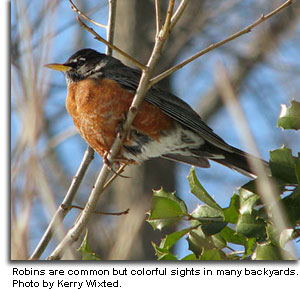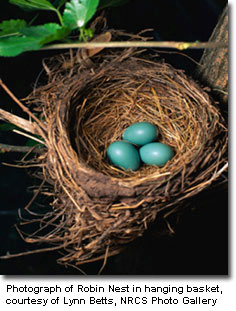American Robin
(Turdus migratorius)
 Description & Range:
Description & Range:
An American Robin is not really a robin. It is the largest of the Thrushes found in North America. This bird was named by the early English settlers who thought it looked very similar to the Robin of their homeland, with both birds having red breasts. Our American Robin is a bird that is familiar to most people, as it has adapted to living in man-made environments.
The adult Robin is 81/2 “ in length and can be as large as 11”. The head is black to dark gray in color, with the male’s head deep black in the spring mating season. The breast feathers are dull red- orange, with the female having a paler color. Juveniles have white spotted breasts until they molt into the adult plumage. White spots around the eyes give the appearance of broken eye rings. Wings are gray and the bills are thin and yellow. Males are slightly larger.
Found year round in Maryland; found from Canada to Mexico.
Habitat:
Robins are considered short distance, daytime migrants. You may not see them in your backyard in the fall or winter, but the birds are found at the local bottomland woods and/ or near berry- bearing trees. The birds that you find in the fall and winter in your area probably were raised just a few hundred miles to the north of you. Robins come back into the backyards in early spring, as the soil warms up making insects and worms available as food.
Diet:
American Robins eat different foods through out the year. In the spring and summer the diet is high in protein with insects and worms consisting of 40% of the bird’s diet. Robins find earthworms by sight and hearing. It is quite common to see the birds running, stopping, cocking their head to hear their prey then tugging the worm out of the ground. These birds certainly help the farmer by eating ground beetles and weevils. They eat fruit year round, with favorites being cherry, dogwood, grape, red cedar, blackberry, holly, blueberry, elderberry. spicebush and viburnums.
 Reproduction:
Reproduction:
These birds breed generally where lawns and other short grass areas are mixed with shrubs and trees. They will also breed in conifer areas where openings or grassy areas are nearby. Robins will sometimes use a nesting platform and the Wild Acres program has plans on how to build one. The breeding season runs from April to August with the birds being capable of raising three broods a year.
Robins are monogamous with pair bonding taking place in early spring. The female builds the nest, which consists of grass, twigs, and mud in an open cup shape. It is lined with soft material. The nest is located in trees or bushes about 5 to 15 feet off the ground.
Males will help feed the young, but the female is the only one that sits on the nest. Once the young are on their own they join the males in the nighttime roosts. Once the female finishes raising her last brood, they will join the nighttime roost that can range from 20 to 200 robins. It is thought that nighttime roosts serve as protection from predators. Robins can also be found in roosts of Grackles and Starlings. These roosts from fall to early spring can move about in a random fashion that is dependent on food sources such as berries. They are capable of landing on a holly tree in late winter and eating the entire berry crop.
Sounds:
American Robins are one of the first birds to sing in the dawn and the last at night. Their song of “chirrup, cherry-up, cherry-up “ or the loud “chup “ is one of the most common wildlife sounds heard in the suburbs. Robins have alarm calls to warn others of predators in the area. Listen to the sound of the American robin.
Status in Maryland:
Currently the population of American Robins is stable. Robins live on average about two years. Since these birds eat so many insects and worms in human environments, they can serve as an indicator of chemical pollution.